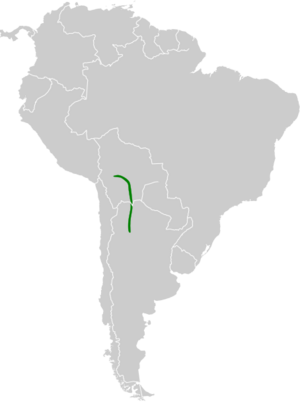Blue-capped puffleg facts for kids
Quick facts for kids Blue-capped puffleg |
|
|---|---|
 |
|
| Conservation status | |
| Scientific classification | |
| Genus: |
Eriocnemis
|
| Species: |
glaucopoides
|
 |
|
| Synonyms | |
|
Eriocnemis dorbignyi |
|
The blue-capped puffleg (Eriocnemis glaucopoides) is a beautiful type of hummingbird. It belongs to a group of hummingbirds called "brilliants". You can find this small bird in parts of Argentina and Bolivia.
Contents
Meet the Blue-Capped Puffleg
The blue-capped puffleg is a small bird, about 9 to 13 centimeters (3.5 to 5 inches) long. It weighs only 4 to 4.5 grams (about 0.15 ounces). This tiny bird has a straight, black beak.
What Does It Look Like?
- Males: They have dark green feathers on their upper body. Their forehead shines with a dark blue color. Their belly is mostly golden green, with a bluish green lower chest. The feathers under their tail are a bright purplish blue. They also have fluffy white feathers around their legs, which look like little puffs! Their tail is long, split into two parts (forked), and is blue-black.
- Females: Their upper body is also dark green, but they do not have the blue forehead. Their throat, chest, and belly are a bright cinnamon-buff color. The feathers under their tail have pale buff edges. The female's tail is also forked, but not as deeply as the male's.
Where Do Blue-Capped Pufflegs Live?
This hummingbird lives in the southern parts of its family's range. You can find it from the La Paz and Cochabamba areas in Bolivia. Its home extends south into northwestern Argentina, in the Salta and Tucumán regions.
Their Favorite Places
Blue-capped pufflegs usually live on humid slopes. These slopes are often covered with grass and thick bushes. They also like the edges of cloudforests. In Argentina, they can sometimes be found in slightly drier areas too. They live at elevations from 1,500 to 3,400 meters (about 4,900 to 11,000 feet) above sea level. They are most common between 2,000 and 2,500 meters (about 6,500 to 8,200 feet).
How Blue-Capped Pufflegs Behave
Staying or Moving?
Generally, blue-capped pufflegs do not move far from their homes. They are mostly "sedentary," meaning they stay in one place. However, they might move to different elevations depending on the season. This has been seen in Argentina and is thought to happen in Bolivia too.
What Do They Eat?
Scientists do not know much about what blue-capped pufflegs eat or how they find food. They have been seen drinking nectar from low-growing plants. Like other hummingbirds, they likely feed on nectar to get energy.
Raising a Family
Blue-capped pufflegs have been observed breeding in November in Bolivia. Beyond this, little is known about their breeding habits. The female bird sits on two eggs to keep them warm. However, how long this takes or when the young birds leave the nest is not yet known.
Their Sounds
The sounds blue-capped pufflegs make are not well studied. As of early 2022, only a few recordings existed. The only known description of their call is a "high-pitched 'zee-zee'".
Conservation Status
The IUCN (International Union for Conservation of Nature) has listed the blue-capped puffleg as a species of "Least Concern". This means they are not currently considered to be in danger. Their population size is not known, but it is believed to be stable. No specific threats to this bird have been identified. While it is generally considered rare, it can be common in certain local areas. It also lives in two national parks in Argentina, which helps protect it.


